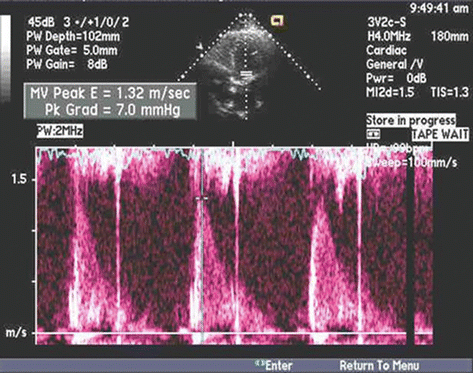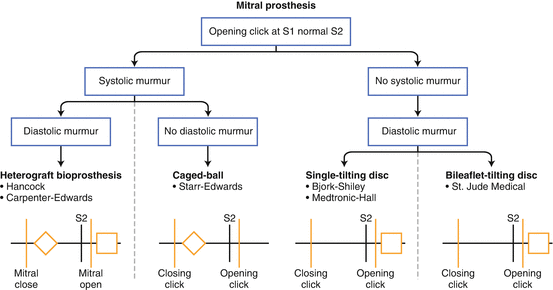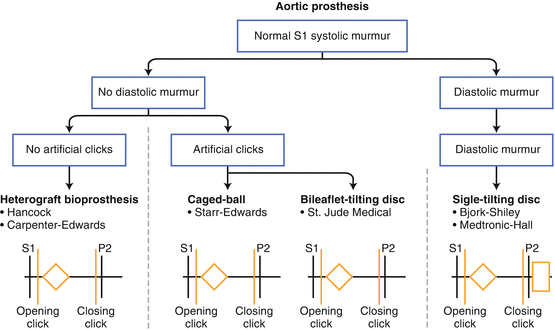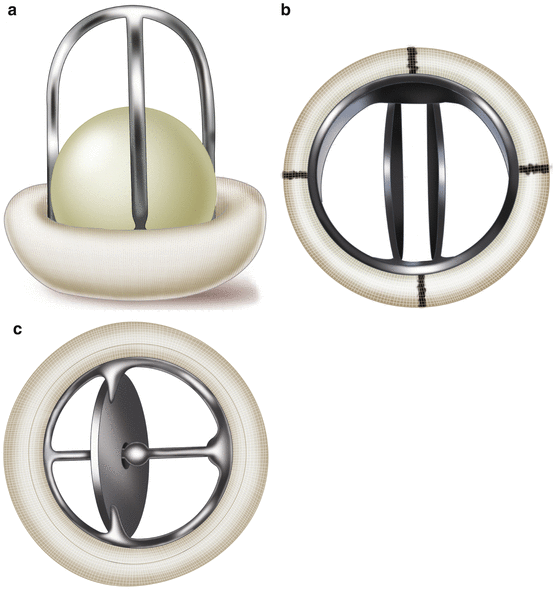Fig. 21.1
Cardiac auscltation findings for a 60 year old female presenting with chest pain and a history of rheumatic heart disease
A loud, crisp mitral closing click and a 2/6 grade murmur was heard from the right upper sternal border to the base of the neck.
A crisp mitral opening click was present at the left sternal border, and at the right sternal border it was a grade 1/4 murmur.
A normal A2 was present with no mitral diastolic murmur.
Test Results
Echocardiogram results:
LV ejection fraction 60 %.
Mild left atrial enlargement (46 mm).
Grade 2 aortic regurgitation with mild valve thickening.
Prosthetic mitral valve with peak velocity of 1.3 m/s (Fig. 21.2).

Fig. 21.2
Echocardiogram of 69 year old female revealing a prosthetic mitral valve with peak velocity of 1.3 m/s
Prosthetic closure velocity noted.
Clinical Basics
Definitions
Prosthetic heart valves are classified as mechanical or biological:
A.
B.
Biological valves.
Primarily made of material from living tissue.
Includes porcine aortic valves, valves produced from bovine pericardium, homografts (valves from other human beings), and autografts (valves from the patient) [1].
Prevalence of Implanted Valves
Complications of Prosthetic Heart Valves
Thromboembolism.
Infective endocarditis.
Valve leaflet failure: uncommon.
Late complications include pannus formation with or without valve dysfunction.
Key Auscultation Features
Mechanical valves have auscultation characteristics including.
Flow murmurs.
Because even normally functioning prosthetic valves have a pressure gradient across them associated with flow acceleration.
The “normal” prosthetic valve does not provide a normal valve orifice area:
Normal mitral valve area is 4–6 cm2.
Prosthetic MVA (depends on type and size):
Starr-Edwards Caged Ball (1.4–2.6 cm2).
St. Jude Bileaflet (1.0–2.03 cm2).
Bjork-Shiley Tilting Disc (1.72–2.2 cm2).
Opening and closing sounds created by mechanical valve components.
Auscultation examples of prosthetic heart valves.
Click here to listen to an example of an auscultation in a patient with aortic valve replacement with a St. Jude valve and view an image of the phonocardiogram (Video 21.1).
Click here to listen to examples of several patients with prosthetic valves, as described by Dr. W. Proctor Harvey (Video 21.2).
Auscultation Differential Diagnosis
Mechanical valves produce very audible opening and closing clicks, to the extent of not needing a stethoscope. Many patients with prosthetic valves hear their own valve clicks.
Mechanical heart valves have different auscultation sounds that are dependent on the following:
Type of valve used.
Position of the valve.
If the functioning of the valve is normal.
In MV mechanical valves, the heart sound sequence simulates mitral stenosis.
Basic Features:
S1: prosthetic closing click.
S2: should be normal.
May be followed by opening click.
Auscultation differences among prostheses in the mitral valve position (Fig. 21.4); Aortic valve findings are shown in Fig. 21.5.

Fig. 21.4
Typical cardiac auscultation findings for a variety of common mitral prostheses

Fig. 21.5
Typical cardiac auscultation findings for a variety of common aortic prostheses
Ball-in-cage Valves.
With normal valve and ventricular function, the Ball-in-cage valve produces the loudest and most distinguishing opening and closing clicks in any position.
A more prominent opening click than closing click.
A 2–3/6 systolic ejection murmur is heard.
No diastolic murmur is heard.
Single Tilting Disc Valves.
An opening click in the mitral position is rarely heard.
A 2/6 systolic ejection murmur is heard.
A 1–2/6 diastolic rumble is typically heard.
Porcine Valves.
An opening click is audible 50 % of the time.
A 1–2/6 apical systolic ejection murmur is heard 50 % of the time.
A diastolic rumble 1/2–2/3.
Bileaflet Valves.
A closing click is very audible while the opening click is typically not heard.
Diastolic rumbling murmur may be heard.
Clinical Clues to the Detection of the Lesion
All prosthetic valves have gradients, so murmurs in the forward flow direction are common.
Regurgitant murmurs are not expected.
Exercising the patient may accentuate a diastolic murmur.
Leads to increase in heart rate and blood flow, which increases the gradient, thereby facilitating murmur auscultation.
Decrease or disappearance of the prosthetic closing sound may represent development of thrombus or fibrous pannus ingrowth.
Closing sound should generally be the loudest sound.
A soft diastolic rumble can occur with MV prosthesis.
Should not be loud.
New diastolic murmur or change may be significant.
Diagnostic Implications of the Auscultation Features
Testing for Valve Thrombosis
Reduction of opening and closing click could point to thrombosis.
Differences in the valve types: mechanical valves tend to have greater problems than biological valves [2].
Antithrombotic Therapy.
Typically required for mechanical valves but not bioprosthetic valves.
What Development of New Murmur May Signify
Valve dysfunction.
Systolic or diastolic murmur.
Paravalvular leak.
Structural Deterioration
Mechanical valves can last 20–30 years.
10–20 % human aortic homograft prostheses fail in 10–15 years.
30–35 % porcine heterograft prostheses fail within 10–15 years.< div class='tao-gold-member'>Only gold members can continue reading. Log In or Register to continue
Stay updated, free articles. Join our Telegram channel

Full access? Get Clinical Tree



